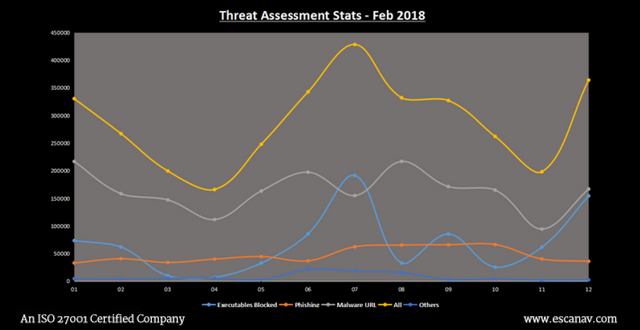The threat assessment stats of this month reads a comparatively high number of Malware URLs making it appearance on the web. These websites attempt to install malware onto your device and malware can be anything that will upset the working of your computer, gather your personal information or even gain total access to your PC. Malware URLs generally look like authentic websites and may ask to install software that is disguised as something that is essential to your computer like an adobe flash player,but the installation leads to compromising your sensitive information.
Escan researchers have also tracked other threats as shown in the graph above.The updated report shows that they all have mostly been safely on the lower end and kept well in check. Among the exceptions,there was a slight spike in executables that were successfully blocked on the 7th Feb 2018.
Updated Reports on Randsomeware Attack

The Ransomeware daily stats show the past week has been a safe and peaceful steady time compared to the fluctuation seen in the 1st week of the month. Unfortunately there was a slight spike in the ransomeware attack count between the 11th and 12th Feb and the reasons needs to be further investigated. Let us take a closer look at the hourly update for the same below.

Ransomware invasion has become unavoidable and happens quite frequently these days. The above hourly record of ransomware attack tells us the how unpredictable an attack can be.The spike in attacks after Sunday could have caused some critical damage to organizations that were not anticipating and protected adequately.
Solution:
- Regarding the Malware URLs, not all Internet security software might be able to detect a malicious software from URLs but they sure can protect your PC from getting infected by them.
- Keep your antivirus software updated at all times, also make sure all your computer’s software, most importantly your operating system is up to date. Generally, hackers use known security problems in software to attack a machine before the software manufacturers can patch the problem.
- Don’t install codecs unless you are very sure they’re safe.
- Don’t open emails that seem suspicious, open them only if you are aware of the source. If you get a link in an email, it is better to visit the main website by typing the address into your browser manually.
- If a website seems off, looks like it’s installing something or is asking permission to install codecs, you’re better off closing the tab and looking for the content elsewhere.
- Ensure that all the software installed in your system is updated frequently, including Oracle Java and Adobe.
- Make sure you either implement MailScan at gateway level or enable Mail Anti-virus on the endpoint in order to block extensions such as *.EXE, *.SCR, *.JS, *.VBE etc. These attachments would infect your system.
- eScanAV Anti-Virus Toolkit (MWAV) is a FREE utility that enables you to scan and clean Viruses, Spyware, Adware and any other Malware that may have infected your computer.







